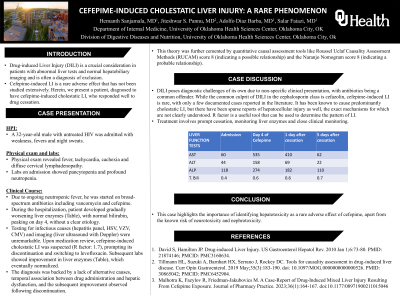Monday Poster Session
Category: Liver
P3064 - Cefepime-Induced Cholestatic Liver Injury: A Rare Phenomenon
Monday, October 28, 2024
10:30 AM - 4:00 PM ET
Location: Exhibit Hall E

Has Audio

Hemanth Sanjamala, MD
University of Oklahoma Health Sciences Center
Oklahoma City, OK
Presenting Author(s)
Hemanth Sanjamala, MD, Jiteshwar S. Pannu, MD, Adolfo Diaz Barba, MD, Salar Faiazi, MD
University of Oklahoma Health Sciences Center, Oklahoma City, OK
Introduction: Drug-induced Liver Injury (DILI) is a crucial consideration in patients with abnormal liver tests and normal hepatobiliary imaging and is often a diagnosis of exclusion. Cefepime-induced LI is a rare adverse effect that has not been studied extensively. Herein, we present a patient, diagnosed to have cefepime-induced cholestatic LI, who responded well to drug cessation.
Case Description/Methods: A 32-year-old male with untreated HIV was admitted with weakness, fevers and night sweats. Physical exam revealed cachexia and cervical lymphadenopathy. Labs on admission showed pancytopenia and profound neutropenia. Given the neutropenic fever, he was started on broad-spectrum antibiotics including vancomycin and cefepime. During the hospitalization, patient developed gradually worsening liver enzymes (Table 1), with normal bilirubin, peaking on day 4, without a clear etiology. Testing for infectious causes (hepatitis panel, HSV, VZV, CMV) and imaging (liver ultrasound with Doppler) were unremarkable. Upon medication review, cefepime-induced cholestatic LI was suspected (R factor: 1.7), prompting its discontinuation and switch to levofloxacin. Subsequent labs showed improvement in liver enzymes (Table 1), which eventually normalized. The diagnosis was backed by lack of alternative causes, temporal association between drug administration and hepatic dysfunction, and the subsequent improvement observed following discontinuation. This theory was further cemented by quantitative causal assessment tools like Roussel Uclaf Causality Assessment Methods (RUCAM) score 8 (indicating a possible relationship) and the Naranjo Nomogram score 8 (indicating a probable relationship).
Discussion: DILI poses diagnostic challenges of its own due to non-specific clinical presentation, with antibiotics being a common offender. While the common culprit of DILI in the cephalosporin class is cefazolin, cefepime-induced LI is rare, with only a few documented cases reported in the literature. It has been known to cause predominantly cholestatic LI, but there have been reports of hepatocellular injury as well, the exact mechanisms for which are not clearly understood. R factor is a useful tool that can be used to determine the pattern of LI. Treatment involves prompt cessation, monitoring liver enzymes and close clinical monitoring. This case highlights the importance of identifying hepatotoxicity as a rare adverse effect of cefepime, apart from the known risk of neurotoxicity and nephrotoxicity.
Note: The table for this abstract can be viewed in the ePoster Gallery section of the ACG 2024 ePoster Site or in The American Journal of Gastroenterology's abstract supplement issue, both of which will be available starting October 27, 2024.
Disclosures:
Hemanth Sanjamala, MD, Jiteshwar S. Pannu, MD, Adolfo Diaz Barba, MD, Salar Faiazi, MD. P3064 - Cefepime-Induced Cholestatic Liver Injury: A Rare Phenomenon, ACG 2024 Annual Scientific Meeting Abstracts. Philadelphia, PA: American College of Gastroenterology.
University of Oklahoma Health Sciences Center, Oklahoma City, OK
Introduction: Drug-induced Liver Injury (DILI) is a crucial consideration in patients with abnormal liver tests and normal hepatobiliary imaging and is often a diagnosis of exclusion. Cefepime-induced LI is a rare adverse effect that has not been studied extensively. Herein, we present a patient, diagnosed to have cefepime-induced cholestatic LI, who responded well to drug cessation.
Case Description/Methods: A 32-year-old male with untreated HIV was admitted with weakness, fevers and night sweats. Physical exam revealed cachexia and cervical lymphadenopathy. Labs on admission showed pancytopenia and profound neutropenia. Given the neutropenic fever, he was started on broad-spectrum antibiotics including vancomycin and cefepime. During the hospitalization, patient developed gradually worsening liver enzymes (Table 1), with normal bilirubin, peaking on day 4, without a clear etiology. Testing for infectious causes (hepatitis panel, HSV, VZV, CMV) and imaging (liver ultrasound with Doppler) were unremarkable. Upon medication review, cefepime-induced cholestatic LI was suspected (R factor: 1.7), prompting its discontinuation and switch to levofloxacin. Subsequent labs showed improvement in liver enzymes (Table 1), which eventually normalized. The diagnosis was backed by lack of alternative causes, temporal association between drug administration and hepatic dysfunction, and the subsequent improvement observed following discontinuation. This theory was further cemented by quantitative causal assessment tools like Roussel Uclaf Causality Assessment Methods (RUCAM) score 8 (indicating a possible relationship) and the Naranjo Nomogram score 8 (indicating a probable relationship).
Discussion: DILI poses diagnostic challenges of its own due to non-specific clinical presentation, with antibiotics being a common offender. While the common culprit of DILI in the cephalosporin class is cefazolin, cefepime-induced LI is rare, with only a few documented cases reported in the literature. It has been known to cause predominantly cholestatic LI, but there have been reports of hepatocellular injury as well, the exact mechanisms for which are not clearly understood. R factor is a useful tool that can be used to determine the pattern of LI. Treatment involves prompt cessation, monitoring liver enzymes and close clinical monitoring. This case highlights the importance of identifying hepatotoxicity as a rare adverse effect of cefepime, apart from the known risk of neurotoxicity and nephrotoxicity.
Note: The table for this abstract can be viewed in the ePoster Gallery section of the ACG 2024 ePoster Site or in The American Journal of Gastroenterology's abstract supplement issue, both of which will be available starting October 27, 2024.
Disclosures:
Hemanth Sanjamala indicated no relevant financial relationships.
Jiteshwar Pannu indicated no relevant financial relationships.
Adolfo Diaz Barba indicated no relevant financial relationships.
Salar Faiazi indicated no relevant financial relationships.
Hemanth Sanjamala, MD, Jiteshwar S. Pannu, MD, Adolfo Diaz Barba, MD, Salar Faiazi, MD. P3064 - Cefepime-Induced Cholestatic Liver Injury: A Rare Phenomenon, ACG 2024 Annual Scientific Meeting Abstracts. Philadelphia, PA: American College of Gastroenterology.
